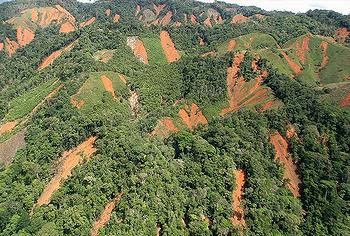
JEJU ISLAND, South Korea, September 9, 2012 (ENS) – A new conservation tool – the Red List of Ecosystems – debuted today at the World Conservation Congress to identify entire ecosystems that are Vulnerable, Endangered, or Critically Endangered based on an agreed, internationally accepted set of criteria for risk assessment.
Known for its authoritative Red List of Threatened Species, which creates the same classifications for individual species, the International Union for the Conservation of Nature, IUCN, today introduced the new Red List at its World Conservation Congress.

Held once every four years, the Congress runs through September 15. Some 8,000 people from 170 countries have gathered on Jeju Island representing government agencies and nongovernmental organizations as well as scientists, business and community leaders.
“Natural environments are under increasing pressure from unsustainable use and other threats,” said Jon Paul Rodriguez, leader of the Ecosystems Red List Thematic Group with the IUCN Commission on Ecosystem Management. “We will assess the status of marine, terrestrial, freshwater and subterranean ecosystems at local, regional and global levels,” he said.
The process for assessing the world’s ecosystems is ongoing, and regional assessments will be published as they become available.
Complete global coverage of all of Earth’s marine, terrestrial, freshwater and subterranean ecosystems is planned for 2025.

An ecosystem is an area of land and/or water and the diverse species living there that interact together. For example, an ecosystem could be a lake or system of lakes, a mountain or mountain range, a river or river basin, a coral reef or group of reefs, an expanse of desert or a set of caves.
The Red List of Ecosystems can help guide conservation action, including land use planning and investment priorities, by evaluating the risks of ecosystem collapse and the potential loss of ecosystem services.
This then forms the basis for actions that conservationists hope will lead to ecosystem restoration and improved governance.
The Red List of Ecosystems also can be used to inform the public about threats to the services that such ecosystems provide, such as clean water, climate regulation and natural products.
“We envision that it could become a one-stop shop for economists, rural communities, local and national authorities, who can use the assessments of the Red List of Ecosystems to better manage the finite resources of our planet,” said Edmund Barrow, who heads the IUCN Ecosystem Management Programme.

The Red List of Ecosystems is intended to be consistent with, and complementary to the IUCN Red List of Threatened Species, which measures extinction risk.
The IUCN believes that the Red List of Ecosystems can influence the policy process of international treaties, such as the Convention on Biological Diversity.
It could guide investments for several Millennium Development Goals, such as poverty reduction and health improvements, as both are dependent on healthy natural environments.
The process for establishing an IUCN Red List of Ecosystems was launched at IUCN’s World Conservation Congress in 2008. Since then the IUCN Commission on Ecosystem Management has focused on defining assessment criteria for categorizing ecosystems according to their risk of collapse.
The IUCN is preparing to introduce another list – a Green List – in two years at the next IUCN World Parks Congress to be held in Australia in 2014.
The Green List of Well-Managed Protected Areas will celebrate successes, rewarding innovation, excellence and enterprise and acting as a benchmark from what the IUCN calls “a threshold of agreed criteria.”

“The IUCN Green List will make a valuable contribution to the more effective conservation of protected areas,” says Trevor Sandwith, director of IUCN’s Global Protected Areas Programme, which is overseeing creation of the new list together with the World Commission on Protected Areas.
“The Green List will serve as a powerful motivator, inspiring protected areas to meet the standards and be shining examples of global best practice,” Sandwith said.
Advantages of inscription on the IUCN Green List include “greater international recognition for the protected area, increased political support, interest in quality tourism and stronger motivation among managers and other staff,” Sandwith said.
The initiative is currently being tested through projects with Parques Nacionales Naturales in Colombia, the Korean National Parks Service and Conservation Assured/Tiger Standards, a WWF-managed tiger conservation program in tiger range states.
Julia Miranda Londoño, director of Parques Nacionales Naturales Colombia, said, “I decided to accept the generous invitation for Colombia to be one of the countries in which this innovative initiative is developed because I find it extremely useful for our country to determine which national parks are doing a good job related to all issues on the management effectiveness of protected areas.”
“Sharing good practices is a very good way to raise the standards of management of the protected areas, which in the end will result in better nature conservation in Colombia.”
The IUCN Green List is intended to assist national governments and their conservation partners to meet their goals under the Convention on Biological Diversity’s Aichi Targets, particularly Target 11, which states that by 2020 at least 17 percent of the world’s terrestrial areas and 10 percent of coastal and marine areas should be “effectively and equitably managed and conserved.”
The IUCN says, “With climate change and increased risks of disasters, we urgently need criteria at the ecosystem level to not only raise awareness about their threats, but to also demonstrate how improved ecosystem management can reduce risks, enhance resilience, and be a means for adaptation.”
Copyright Environment News Service (ENS) 2012. All rights reserved.
© 2012, Environment News Service. All rights reserved. Content may be quoted only with proper attribution and a direct link to the original article. Full reproduction is prohibited.
